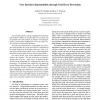Free Online Productivity Tools
i2Speak
i2Symbol
i2OCR
iTex2Img
iWeb2Print
iWeb2Shot
i2Type
iPdf2Split
iPdf2Merge
i2Bopomofo
i2Arabic
i2Style
i2Image
i2PDF
iLatex2Rtf
Sci2ools
DSN
2005
IEEE
2005
IEEE
User Interface Dependability through Goal-Error Prevention
User interfaces form a critical coupling between humans and computers. When the interface fails, the user fails, and the mission is lost. For example, in computer security applications, human-made configuration errors can expose entire systems to various forms of attack. To avoid interaction failures, a dependable user interface must facilitate the speedy and accurate completion of user tasks. Defects in the interface cause user errors (e.g., goal, plan, action and perception errors), which impinge on speed and accuracy goals, and can lead to mission failure. One source of user error is poor information representation in the interface. This can cause users to commit a specific class of errors – goal errors. A design principle (anchor-based subgoaling) for mitigating this cause was formulated. The principle was evaluated in the domain of setting Windows file permissions. The native Windows XP file permissions interface, which did not support anchorbased subgoaling, was compared t...
Computer Networks | DSN 2005 | User | User Error | User Interface |
| Added | 24 Jun 2010 |
| Updated | 24 Jun 2010 |
| Type | Conference |
| Year | 2005 |
| Where | DSN |
| Authors | Robert W. Reeder, Roy A. Maxion |
Comments (0)

